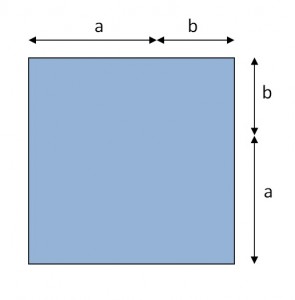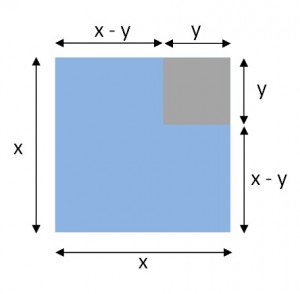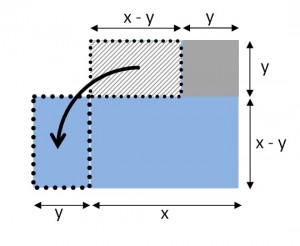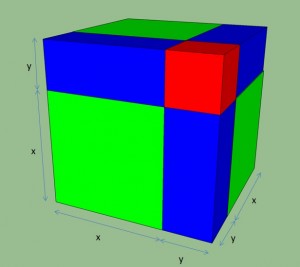Let’s start with a silly question about math vocabulary:
Why do some powers have special names?
The expression “ 35 ” means “multiply 3 by itself 5 times”: 35=3×3×3×3×3. I’m not really worried about how to calculate this right now. I just want to agree that we call it “three to the fifth”. And raising to the fifth power doesn’t have any other special name.
And when we talk about x7 , we say “x to the seventh”. Again, no special name.
But there are two powers that have additional names. When we talk about say, 52, we most often call it “5 squared”. Raising to the second power is called “squaring”. Raising to the third power is called “cubing”. And , of course, you knew that. But it is easy to overlook why these (and only these) powers have these additional names. The additional names have geometric meaning.
- When you raise a number to the second power, you are calculating the area of the square with a side of that length. So we call it “squaring”.
- When you raise a number to the third power, you are calculating the volume of the cube with an edge of that length. So we call it “cubing”.
- If we lived in 4 spatial dimensions, I bet we would have a name for raising things to the fourth power as well.
It is easy to overlook the geometric meanings of squaring and cubing. I know this because of how my students respond when we talk about FOIL-ing to square a binomial. The geometric meaning always seems to catch them by surprise. But it is usually a happy discovery.
CURSES! FOILed AGAIN
For those of you who haven’t seen it in a while, I’ll review. FOIL is a mnemonic device used to help students remember how to multiply binomials. It is the result of distributing multiplication over addition multiple times. You can use it to square binomials.
You start with an expression such as: (x + y)2
You re-write it: (x + y)(x + y)
Now, think of that first term as the multiplier and think of the second term as the sum over which multiplication is distributed. You get:
(x + y)x + (x + y)y
Then you can distribute each of those as well. That leads you to: x2 + xy + xy + y2
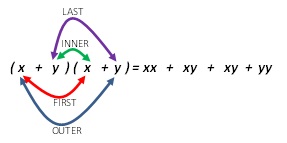
Before we combine the middle two terms, note that there are 4 pairings. That’s where the mnemonic FOIL comes in. You get the pairs by multiplying the FIRST terms, the OUTER terms, the INNER terms and the LAST terms.
I don’t have a problem with this mnemonic itself. It’s kind of robotic, but I understand that you have to make certain processes automatic so that you can get to the next step. I wouldn’t want my students to have to go back to the distribution property every time they see (x + y)2. In fact, I don’t want them to have to foil it either. I want them to know that (x + y)2 = x2 + 2xy + y2 not because they have memorized it but rather because they can picture it!
THE GEOMETRIC MEANING OF (x + y)2
We call it “squaring” because it gives us the area of the square.
So (x + y)2 is the area of the square with length (x + y). Now, let’s draw some pictures.
Here is a line segment with a length of x + y:

And here is the square with a side that has that same length:
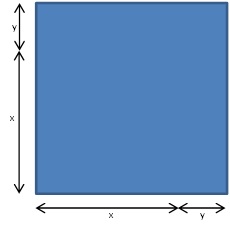
The area of that square is certainly (x + y)2.
But what if we break that square into smaller regions?

The picture tells the story in a more intuitive and memorable way than foiling ever could. We are clearly looking at a big square (with area = x2), a little square (with area = y2), and two identical rectangles (each with area = xy). This is the diagram that goes with the rule for binomial squares:
(x + y)2 = x2 + 2xy + y2
But it’s better with pictures.
Next post — higher dimensions.
And then x2 – y2. Spoiler: it really is the difference of two squares.

